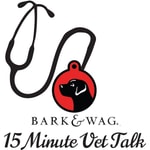Bark n Wag 15 Minute Vet Talk – Détails, épisodes et analyse
Détails du podcast
Informations techniques et générales issues du flux RSS du podcast.

Bark n Wag 15 Minute Vet Talk
Polly ReQua
Fréquence : 1 épisode/10j. Total Éps: 310

Classements récents
Dernières positions dans les classements Apple Podcasts et Spotify.
Apple Podcasts
🇺🇸 États-Unis - petsAndAnimals
01/08/2025#100🇺🇸 États-Unis - petsAndAnimals
31/07/2025#69🇺🇸 États-Unis - petsAndAnimals
22/07/2025#73🇺🇸 États-Unis - petsAndAnimals
19/07/2025#96🇺🇸 États-Unis - petsAndAnimals
13/07/2025#74🇺🇸 États-Unis - petsAndAnimals
10/07/2025#83🇺🇸 États-Unis - petsAndAnimals
04/07/2025#71🇨🇦 Canada - petsAndAnimals
05/06/2025#90🇨🇦 Canada - petsAndAnimals
04/06/2025#84🇨🇦 Canada - petsAndAnimals
03/06/2025#70
Spotify
Aucun classement récent disponible
Liens partagés entre épisodes et podcasts
Liens présents dans les descriptions d'épisodes et autres podcasts les utilisant également.
See all- https://www.instagram.com/
5091 partages
- https://www.instagram.com/winpropet
4 partages
- https://www.facebook.com/
4210 partages
- https://facebook.com/events/s/
3 partages
- https://www.facebook.com/winpropet
3 partages
Qualité et score du flux RSS
Évaluation technique de la qualité et de la structure du flux RSS.
See allScore global : 38%
Historique des publications
Répartition mensuelle des publications d'épisodes au fil des années.
Ellie Laks, Author, discusses her new book, Cow Hug Therapy
dimanche 14 juillet 2024 • Durée 12:41
Cow Hug Therapy
How The Animals at the Gentle Barn Taught Me about Life, Death, and Everything In Between.
Autographed copy of the inspirational story of the compassionate and wise animals of the Gentle Barn and how they became a therapeutic salve for countless guests — and mentors for all of us in how to live and die
In Cow Hug Therapy, Ellie Laks, founder of the Gentle Barn Foundation, shares the extraordinary journey that started with her first teacher, Buddha — not the religious figure, but a rescued miniature Hereford cow. One evening Buddha wrapped her neck around an exhausted and upset Laks and transferred a singular form of healing and comfort with an incredible impact. Understanding that this was something to be shared with others, Laks developed Cow Hug Therapy, a groundbreaking approach to emotional healing that has proved effective for trauma, illness, disabilities, addiction, grief, and stress.
Cow Hug Therapy is a colorful and compelling narrative of the healing mavens of the barnyard through the years and their individual stories of being rescued from trauma and treated with love and respect. These animals have transformed lives and ignited breakthroughs, newfound purpose, and freedom, including for a young mother who lost her baby, a suicidal teenager, a wounded serviceman, an open-heart surgery patient, and many more.
Media outlets including ABC’s Good Morning America, NBC’s TODAY show, and The Atlantic magazine have featured numerous stories of the hopeless beginning to thrive at the Gentle Barn. A testament to empathy and the mission to heal animals, people, and the planet, Cow Hug Therapy captures a remarkable journey of transformation and serves as a beacon of hope for all seeking healing and connection.
Make sure you buy this amazing book!
Learn about Shepherd's Rest Goat and Sheep Rescue's G.O.A.T Progam. Go Out and Thrive!
dimanche 30 juin 2024 • Durée 21:25
“Putting animals and people together in a way that is healing for both” is the core mission of Shepherd’s Rest Goat and Sheep Rescue. Through the Animal Assisted Therapy Program, we believe we can create an impact that echoes in the lives of our clients far beyond the boundaries of the rescue.
Please visit https://www.shepherdsrestrescue.com
Tips for cold weather when you have dogs
dimanche 31 mars 2024 • Durée 05:37
Exposure to winter’s dry, cold air and chilly rain, sleet and snow can cause chapped paws and itchy, flaking skin, but these aren’t the only discomforts pets can suffer. Winter walks can become downright dangerous if chemicals from ice-melting agents are licked off of bare paws. To help prevent cold weather dangers from affecting your pet’s health, check out our top 10 cold weather safety tips from our experts at the ASPCA Animal Poison Control Center (APCC).
- Remember, if it’s too cold for you, it’s probably too cold for your pet, so keep your animals inside. If left outdoors, pets can freeze, become disoriented, lost, stolen, injured or killed. In addition, don’t leave pets alone in a car during cold weather, as cars can act as refrigerators that hold in the cold and cause animals to freeze to death.
- Keep your home humidified and be sure to towel dry your pet as soon as they come inside. Repeatedly going into the cold and then comin back into a warm home can cause itchy, flaking skin. Pay close attention to their feet and in-between their toes and remove any snow balls from between their foot pads to prevent and treat skin irritation in the winter.
- Massage petroleum jelly or other vet-approved paw protectants into paw pads before going outside to protect from salt and chemical agents. Booties can provide even more coverage and can also prevent sand and salt from getting lodged between bare toes and causing irritation. Use pet-friendly ice melts whenever possible.
- Never shave your dog down to the skin in winter. A longer coat will provide more warmth. If your dog is long-haired, simply trim them to minimize the clinging ice balls, salt crystals and de-icing chemicals that can dry their skin, and don’t neglect the hair between their toes. If your dog is short-haired, consider getting them a coat or sweater with a high collar or turtleneck with coverage from the base of the tail to the belly.
- After each walk, make sure to wash and dry your pet's feet and stomach to remove ice, salt and chemicals. Don't forget to check for cracks in paw pads or redness between the toes. You may also want to bring a towel on long walks to clean off stinging, irritated paws.
- Bathe your pets as little as possible during cold spells. Washing too often can remove essential oils and increase the chance of developing dry, flaky skin. If your pooch must be bathed, ask your vet to recommend a moisturizing shampoo and/or rinse.
- Thoroughly clean up any anitfreeze spills. Like coolant, antifreeze is a lethal for dogs and cats. Be sure to thoroughly clean up any spills from your vehicle, and consider using products that contain propylene glycol rather than ethylene glycol. Additionally, cold weather chemicals like ice melts can be dangerous when ingested, so always be mindful and keep chemicals up and out of paws' reach.
- Feed your pet a little extra in the winter months. Pets burn extra energy by trying to stay warm in wintertime. Feeding them a little bit more can provide much-needed calories, and making sure they have plenty of water to drink will help keep them well-hydrated and their skin less dry.
- Make sure your companion animal has a warm place to sleep, off the floor and away from all drafts. A cozy dog or cat bed with a warm blanket or pillow is perfect.
- Never let your dog off leash on snow or ice, especially during a snowstorm. Dogs can lose their scent in the snow and easily become lost. More dogs are lost during the winter than during any other season, so make sure your dog always wears an ID tag.
Be sure to keep these tips top of mind this winter so that you and your furry friends can stay warm, cozy and safe.
Indy & Olly's founder announces the new holiday bandana line available for your dog(s)
dimanche 21 novembre 2021 • Durée 06:41
Indy & Olly’s is a for-purpose dog bandana company that helps dogs in animal rescues and shelters get adopted by improving pet adoption photos…because dogs look #betterwithbandanas. Today we learn about the new holiday styles avaialbe for your dog.
Indy & Olly’s got its start in 2019 out of Evergreen, Colorado, when our founder decided it was time to honor two of her favorite dogs with a business that gives back. Indy & Olly’s—the company—has several goals -
-
Help homeless dogs find homes
-
Be a platform for promoting dog adoptions, spreading the spay & neuter message and keeping dogs out of shelters.
-
Care for the earth and its inhabitants in all we do.
Visit https://www.indyollys.com/
Cindy Myers, Animal Intuitive, discusses her November webinar schedule to get your pet ready for the Holidays.
jeudi 11 novembre 2021 • Durée 16:44
Visit https://yourenergyhealer.com/ to sign up for the webinars
I’ve always been a good listener. However, twenty years ago, I would have found it hilarious if you told me that I’d be working as an intuitive energy healer while living on an alpaca farm! But, here I am with a herd of 24 alpacas, 3 dogs and 3 cats working as a Medical Intuitive! I believe that the sum of our life experiences can lead us to our true calling in life. There are many paths to finding our way to our authentic selves.
It took many years, multiple and diverse career paths, and tough life challenges to finding my true calling. The life lessons were invaluable that led me to this meaningful life. I learned about frequencies and Radars while working as an Engineer for the Navy and now I am a Radar! I learned all about stress and how harmful it is to our body, mind and spirit while being my mom’s caregiver through her final years. And there was an amazing gift I created out of the house fire I experienced due to an arsonist. Losing my belongings led me to discovering myself. And I found the courage to embrace and pursue my calling of intuitive energy work. It is an honor and humbles me to do this work for people and their animals.
I love sharing my intuitive abilities with both animals and humans. I look forward to helping you restore your energy balance so you can live an abundantly joy filled life!
Signs of an aging pet with Dr. Susan McMillan
vendredi 29 octobre 2021 • Durée 13:32
Everybody gets old, including your dog. That adorable little pup that grew into your constant companion may be showing signs of getting old, both physical and mental. Different breeds and sizes of dog age at different rates. A large breed like a Great Dane is considered senior at around six years old. A small dog, like a Chihuahua, for example, may not be considered old until she is seven to ten years old. The more tuned-in you are to the typical signs, the sooner you can help your dog age gracefully.
Physical signs that your dog is aging- Cloudy eyes or difficulty seeing: Eye cloudiness (nuclear sclerosis) can happen so gradually that you might not notice it right away. While it’s a fairly common occurrence in senior dogs and doesn’t affect vision, it may also be a sign of cataracts or other eye diseases, most of which are easily treatable. Your dog may also start bumping into things or have trouble locating a toy on the floor or other familiar objects. This could signal vision loss.
- Horrible breath: While doggie breath isn’t uncommon at any age, if your dog seems to suddenly have awful breath, it could indicate gum disease, tooth decay, or infection. The immune system weakens as dogs age and they are not able to fight off infections as easily as they did when they were younger. Along with a good dental cleaning, your vet may decide to do blood work to rule out infection.
- Slowing down or difficulty getting around: An older dog may have trouble with stairs, jumping into the car, or just getting up after a nap. You might notice weakness in her back legs. While we all slow down as we age, your dog’s mobility issues could be caused by arthritis or another degenerative disease. Along with any medication or supplements your vet recommends, you will have to adjust your dog’s exercise regimen to slower and shorter walks or a new exercise routine. Swimming, for example, is gentle on the body and many dogs love it.
- New lumps and bumps: Some dogs are prone to harmless fatty lipomas, but these lumps under the skin are more common as dogs age. However, any new lump should be checked by a veterinarian to rule out a malignant tumor.
- A change in weight: It’s not surprising that older, less active dogs sometimes gain weight and you may have to adjust your dog’s diet and exercise to maintain a healthy weight. However, you should also pay attention if your senior dog loses weight. This could be the result of reduced muscle mass, which is common in older dogs, or it might be caused by reduced appetite, poor absorption of nutrients, or a digestive illness. If your dog loses more than 10 percent of her body weight in a few months, or even in a year, consult your vet.
- Incontinence or difficulty “going:” If your dog suddenly seems to forget his housetraining or seems to strain when urinating, these could be signs of a urinary tract infection or kidney disease. However, incontinence is not unusual in elderly dogs and there are medications that can help.
Physical changes aren’t the only differences you may notice in your dog as he ages. Changes in behavior can signal an underlying physical problem or may be a normal sign of aging. For example, if your sweet pup has suddenly turned into Grumpy, she may be in pain caused by arthritis or be experiencing some other physical discomfort. Or your high-energy companion may be sleeping hours a day. Older dogs need more sleep, just let him nap.
However, changes in behavior may also be the result of canine cognitive dysfunction syndrome (CCDS). According to a study at the National Center for Biotechnology Information, CCDS affects 14-35 percent of dogs over eight years old. A dementia similar to Alzheimer’s in humans, CCDS can bring about pronounced changes in your dog’s everyday behavior:
- Fear of familiar people or objects.
- Changes in the sleeping-waking cycle, including restlessness or pacing at night.
- Increased barking and vocalization.
- Repetitive or compulsive behaviors.
- Forgetting commands and cues that she once knew.
- House soiling.
- Increased anxiety.
- Confusion and disorientation.
- Marked change in activity level.
Your vet will be able to make a diagnosis by asking you simple questions during the appointment. While there is no cure for CCDS, there are some new medications and therapeutic options your vet can discuss with you.
How can you help your aging dog?The single most important thing you can do is check with your vet if you see any of these physical or mental changes. The vet can determine the underlying medical causes and prescribe treatments. He can also help you make some decisions about your dog’s care going forward: changes in diet and exercise, changes you can make around the house, or in the daily routine.
We spoke with Wendy Stevens, a former veterinary technician at VCA Alton Road Animal Hospital in Miami Beach, with 30 years experience, and she said that pet owners’ greatest fear is having to make a decision about their pets’ end of life, and that fear may make an owner unwilling to visit the vet. They may also not be educated about the signs of aging and take a “wait-and-see” attitude. The cost of care is also an issue for many pet owners.
Our dogs give us many years of love and loyalty and it’s only natural to want to make their senior years as comfortable and enjoyable as possible. Aging is a normal part of life and with some vigilance and attention to your dog’s health, these can truly be “golden years.”
Get Your Free AKC eBookDoes your dog have an ear infection with Dr. Laura Brown
dimanche 24 octobre 2021 • Durée 07:01
The shape of a dog's ear canal makes your canine companion more susceptible to ear infections than people are. Not only that, dogs that swim frequently and dogs with adorable floppy ears are even more prone to ear infections due to moisture that gets trapped in the ear, creating the ideal environment for bacteria to thrive.
The good news is that in many cases, with a little care, you can prevent your dog from developing an ear infection. If your dog does develop an infection, by seeing a vet early there's a good chance that the infection can be cleared up quickly and easily.
On the other hand, if your dog's ear infection goes untreated in the early stages a much more serious infection can develop, possibly causing serious symptoms such as facial paralysis, balance and coordination issues, and severe pain.
Causes of Ear Infections in DogsThere are a number of different causes of ear infections in dogs. Bacteria in the ear is a primary cause of infections however yeast, fungus and ear mites can all cause your pup's ears to become infected and painful. Other causes of dog ear infections include foreign objects lodged in the ear, trauma, and tumors or polyps.
Types of Dog Ear InfectionsThere are three types of ear infections seen in dogs;
- Otitis externa infections affect the outside of the ear.
- Otitis media indicates an infection in the dog's middle ear.
- Otitis interna which are infections of your pet's inner ear.
If your pooch has developed an ear infection they are likely to feel very uncomfortable and in some cases, the ear may be very painful. If your dog shows any of the following signs of an ear infection contact your vet straight away to book an examination for your pet. Early treatment of ear infections can help to prevent more severe symptoms from developing.
Common signs of ear infections in dogs include:
- Scratching or pawing at the ear
- Yellow, brown or bloody discharge
- Redness inside of the ear
- Odor in the ear
- Head shaking or tilting
- Swelling of the ear
- Crusts or scabs just inside the ear
- Rubbing ear on floor or furniture
If your dog is suffering from a more severe ear infection you may notice other symptoms such as:
- Loss of balance or coordination
- Signs of hearing loss
- Walking in circles
- Unusual eye movements
If your pooch is diagnosed with an ear infection your vet will take the time to clean your dog's ear with a medicated cleanser and prescribe any antibiotics or anti-inflammatory medication appropriate for treating your pet's ear infection. The vet may also prescribe a topical medication and instruct you on how and when to apply it to your dog's ear at home.
When caught early and provided with appropriate treatment, uncomplicated dog ear infections typically clear up within just a week or two. If your pup's ear infection is more severe or is due to an underlying health condition, treatment may be more challenging and may take months to resolve. In many cases, more severe cases result in chronic or repeated ear infections over the course of the dog's lifetime.
Carefully following your veterinarian's instructions is the key to clearing up your dog's ear infection as quickly as possible. Not finishing prescriptions, or stopping treatment before the infection has completely cleared can lead to a recurring infection that becomes increasingly difficult to treat.
Taking your pup back to the vet for a follow-up appointment is highly recommended for dog ear infections. While it may look as if the infection has cleared there may still be traces of infection that are difficult for pet parents to spot.
Preventing Ear Infections in DogsOur vets believe that prevention is always better than treatment. To help prevent your dog from developing an ear infection it is important to keep your pup's ears clean and dry.
Speak to your vet about the best cleaning solution to use for your dog's ears, and take the time to gently clean your pup's ears every week.
Note: The advice provided in this post is intended for informational purposes and does not constitute medical advice regarding pets. For an accurate diagnosis of your pet's condition, please make an appointment with your vet.
Is your pup showing signs of a painful ear infection? Contact Thomasville Veterinary Hospital Urgent Care + Surgery for urgent vet care for your pup. Our Davidson County emergency vets are here to help your dog whenever your regular vet is unavailable.
Tips on teaching your dog to shake with Kersti Moss, professional dog trainer
dimanche 17 octobre 2021 • Durée 05:08
After training your dog a few basic commands like sitting and staying, you can move on to more advanced tricks, like teaching them to shake your hand (sometimes referred to as “giving a paw”). Whether you’re an experienced dog owner or a newbie, by following a few simple steps (and having some patience), your dog is well on their way to learning this cool new trick. As a bonus, this trained behavior comes in handy when you need to wipe off our dog’s muddy paws or even trim their nails.
Steps to Teaching Your Dog to ShakeHave your dog “sit.”
Grab a treat and show it off before you hide it in your closed fist.
Hold out your fist, palm facing up, at about your dog’s chest level.
Your dog should naturally paw at your fist to get to the treat. When they do, open your hand and let them have the treat and give them plenty of praise. Repeat these steps several times until your dog “gets it.”
Repeat steps 1–4, but this time, without holding a treat in your hand. As soon as your dog paws at your fist, give them a treat from your other hand.
Once your dog understands what you want them to do, it’s time to add the word “shake” — add this word just before you put out your hand. Now your dog is shaking!
We recommend practicing for 5-10 minutes per day as to not frustrate or tire out your dog. If you’d like, you can incorporate a clicker into this routine, “clicking” immediately before giving the treat. If your dog isn’t getting the trick down as quickly as you’d like, be sure not to scold and instead to just offer encouragement along the way.
By training your dog to shake (as well all the other foundational behaviors like sitting and staying), you’ve helped keep them safe, improved their confidence, and given yourself something to show off!
ZPC-00527R1
The Zoetis Petcare TeamCindy Myers, Animal Intuitive, discusses her free October webinar and her new book.
vendredi 1 octobre 2021 • Durée 07:15
Tips on how to stop leash pulling with Kersti Moss from Dog Training Camp USA
lundi 27 septembre 2021 • Durée 09:09
Many people think that dogs just innately know how to walk politely on a leash, but this skill is something that needs to be trained. It’s an important skill to teach, and one you’ll value every time you take your dog out for a walk. Dog training expert and AKC Family Dog training and behavior columnist Kathy Santo offers the following tips:
Training Your Dog to Walk on a LeashIntroduce the puppy to the collar or harness and leash. Start out by letting him get used to wearing a collar or harness and a leash. Let him wear them for short periods of time in the house while you are playing with him and giving him treats. The puppy should love collar-and-leash time because it represents food and fun.
Teach a cue. Introduce your puppy to a sound cue that means, “food is coming.” Some people like to click and treat, some people use a word like “yes,” and some people cluck their tongue. Whichever you use, the method is the same: In a quiet, distraction-free area, with the puppy on a leash and collar, make the sound. The second your puppy turns toward you and/or looks at you, reward him with a treat. After a few repetitions, you’ll notice your puppy not only looking at you, but also coming over to you for the treat.
Make the puppy come to you. While he’s on his way to you, still wearing the leash and collar, back up a few paces and then reward him when he gets to you. Continue the progression until your puppy, upon hearing the cue noise, comes to you and walks with you a few paces. Remember that puppies have a short attention span, so keep your sessions short, and end them when your puppy is still eager to do more, not when he’s mentally exhausted.
Practice inside. Now that your puppy understands how to come to you, practice walking a few steps in a room with little distraction. Feeling and seeing the leash around him will be enough of a challenge. Offer treats and praise as your puppy gets used to coming to you, as described above, with a leash on.
Take it outside. Finally, you’re ready to test your puppy’s skills in the Great Outdoors. There will be new challenges with this step because all the sounds, smells, and sights your puppy encounters will be intriguing and new to him. Be patient and keep the first walks short. While you’re on a walk, if your puppy looks as if he’s about to lunge toward something or is about to get distracted (you’ll notice this because you will keep your eyes on him at all times), make your cue sound and move a few steps away. Then reward him with a treat for following you.









